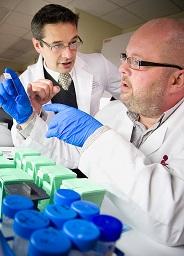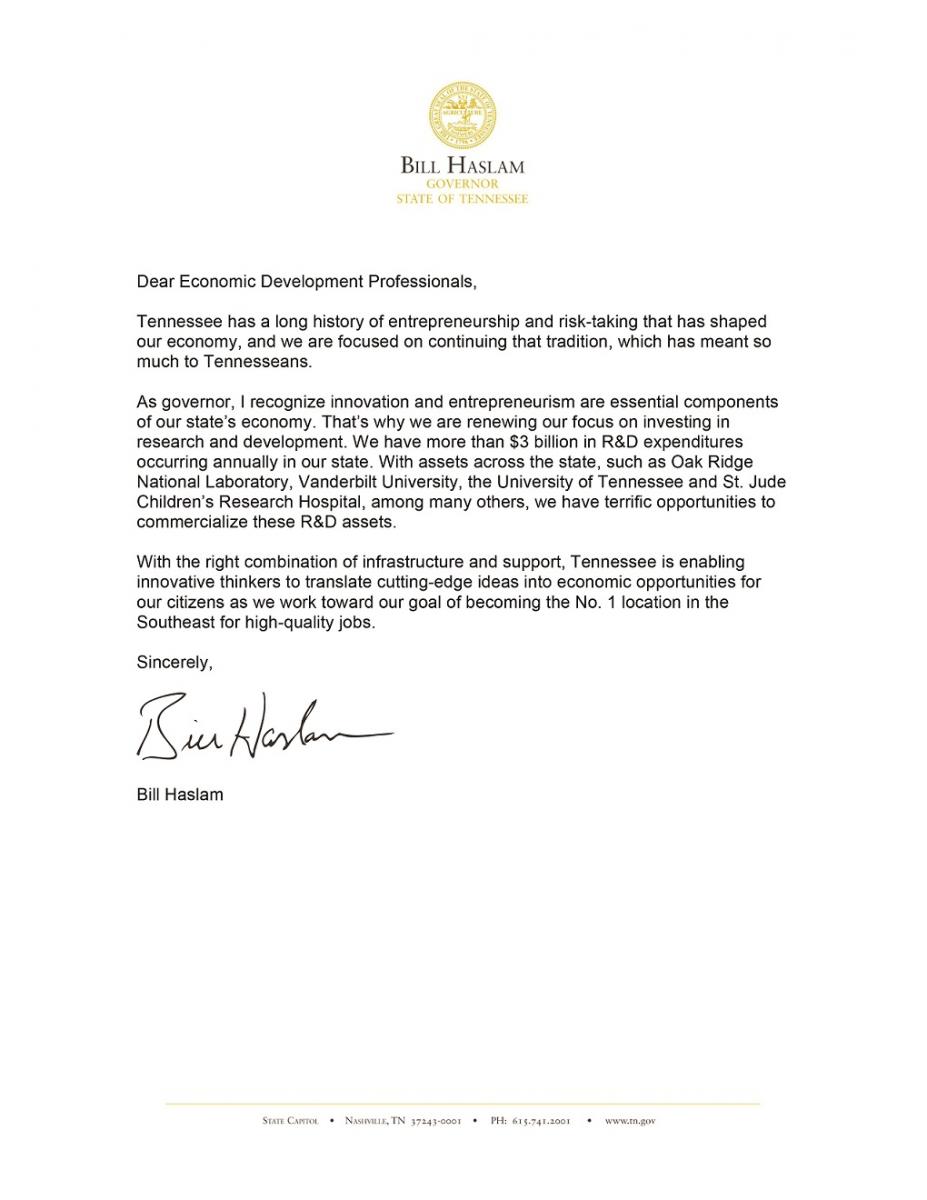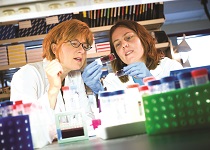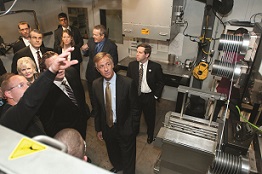

Tennessee continues to take center stage when it comes to economic development, standing out amongst the competition and attracting new business from around the world, as well as growing existing industries and supporting entrepreneurship. A move to Tennessee allows companies to take advantage of its central location, tap into a highly qualified workforce in a right-to-work state, enjoy a low tax burden and collaborate with an administration that is business-friendly with the goal of making Tennessee the No. 1 place in the Southeast for high-quality jobs.
But Tennessee’s attractiveness doesn’t stop there: approximately $3 billion is invested annually in research and development across Tennessee’s internationally recognized research institutions. Research and development drives Tennessee’s economy, providing the groundwork for continued innovation and discovery.
Every day, thousands of scientists across the state — from St. Jude Children’s Research Hospital, Vanderbilt University, Oak Ridge National Laboratory and the University of Tennessee — channel this funding into research that may find the cure for cancer or create the next technological breakthrough.

St. Jude Children’s Research Hospital is leading the way in its mission to find cures for children with cancer and other catastrophic diseases through research and treatment. It is the first institution established for the sole purpose of conducting basic and clinical research and treatment into catastrophic childhood diseases, mainly cancer.
Research is a major part of St. Jude: during the past five years, 81 cents of every dollar received has supported the research and treatment at the hospital and a recent expansion bolstered the hospital’s research and treatment efforts, while more than doubling the size of its original campus. The campus now has 2.5 million square feet of research, clinical and administrative space dedicated to finding cures and saving children.
“St. Jude Children’s Research Hospital discoveries often lead to intellectual property that we are eager to license to companies that can translate them into products that benefit communities around the world,” St. Jude Children’s Research Hospital director and CEO Dr. William E. Evans said. “We are eager to see more of these companies in Tennessee for many reasons, including the increased likelihood of successful translation when the innovator can remain closely involved, which in turn means greater speed in benefitting patients. We also like to see discoveries made here provide economic benefits to the communities in which we live.”
Vanderbilt University
Vanderbilt University and Vanderbilt University Medical Center are nationally recognized academic institutions. Researchers on both campuses are at the forefront of posing innovative solutions to some of the most challenging questions facing us today. In academic year 2011, faculty across all disciplines received over $587 million in external funding for research. Vanderbilt is one of only 14 universities ranked in the top 25 on each of two key indicators: U.S. News & World Report’s “Best Universities and Colleges” (ranked 17) and federal obligations for science and engineering research and development (ranked 21).
“Vanderbilt will continue to seek ways to contribute to the vitality of the state of Tennessee in education, health care, research, entrepreneurship and myriad other realms,” Vanderbilt University Chancellor Nicholas Zeppos said. “We are always seeking partnerships across the state for research opportunities that lead to development and business that can provide jobs and ultimately improve the quality of life for all citizens.”
Research is one of Vanderbilt University Medical Center’s core missions. "Vanderbilt has been fortunate to develop deep collaborations with industry partners to turn innovations covering a broad spectrum of scientific and medical disciplines — from robotics and imaging to drug discovery, healthcare informatics and personalized medicine — into products that will someday profoundly impact society," Assistant Vice Chancellor for Technology Transfer in the Vanderbilt Center for Technology Transfer & Commercialization Alan Bentley said.

Tennessee is home to Oak Ridge National Laboratory, the U.S. Department of Energy’s largest multidisciplinary science lab and a test bed for technologies responsible for creating or transforming industries including nuclear medicine, medical imaging, advanced manufacturing and more.
“ORNL draws researchers from around the world, and we have a track record of helping take our discoveries to market,” ORNL Director for Science and Technology Partnerships Jim Roberto said. “We see ourselves as integral to American competitiveness, and as partners with business and industry.”
ORNL is home to the most powerful supercomputer in the world, Titan, which is available to companies trying to solve big problems without the expense of costly prototypes or delays caused by limited processing power.
The lab’s neutron facilities have helped a variety of firms improve their products, from consumer items to durable goods, by showing how they work at an atomic level under defined conditions.
ORNL recently opened a Manufacturing Demonstration Facility where companies are coming to test new techniques for making products stronger, lighter, more quickly and less expensively.
And the lab’s Carbon Fiber Technology Facility is allowing industry partners including Dow and Ford to bring lower-cost carbon fiber to market.
Some 50 companies to date are members of the ORNL-led Carbon Fiber Consortium.
University of Tennessee
In 2012, the University of Tennessee, Knoxville, invested more than $208 million in support of the research enterprise.
"These funds drive our discovery enterprise and our generation of new knowledge. They also have important multiplier effects in the local and state economies,” UT Vice Chancellor for Research and Engagement Taylor Eighmy said. “For example, our federal funding supports hundreds of graduate student research assistantships and undergraduate research. These projects typically lead to intellectual property and spinouts.”
Eighmy added, “There were three start-ups in Knoxville last year and licensing income was more than $1 million. Other sources of funds, particularly corporate funds, help us conduct applied research and development crucial to the success of the sponsoring company.”
The University of Tennessee manages and operates Oak Ridge National Laboratory through UT-Battelle with enthusiastic and substantial support from the state of Tennessee.
In 2010, the U.S. Department of Energy extended UT-Battelle's contract to manage Oak Ridge National Laboratory for another five years. The infusion of combined scientific capability UT and ORNL bring to the region enable addressing the most pressing scientific questions of today and tomorrow.
UT-Oak Ridge has also paid dividends in economic development. Since UT began managing ORNL, the technology commercialization program has spun off more than 90 new companies. These companies lead to new jobs and opportunity in the East Tennessee area and beyond, and the program serves to draw the most talented researchers to the lab.
UT is affiliated with “Cherokee Farm Innovation Campus,” the nation’s only R&D park where the resources of a major research university and a leading national laboratory (ORNL) are combined with globally recognized researchers expressly for the benefits of its tenants. Cherokee Farm is located on 188 acres on the banks of the Tennessee River in Knoxville, Tennessee. The campus includes 16 building sites that support approximately 1.6 million square feet of development and is ready for immediate development.
Related Agencies
- Bristol Tennessee Essential Services
- West Tennessee Industrial Association
- TVA Tennessee Valley Authority Department of Economic Development
- Joint Economic & Community Development Board of Wilson County, Tennessee
- Goodlettsville Economic Development
- Tennessee Department of Economic & Community Development

